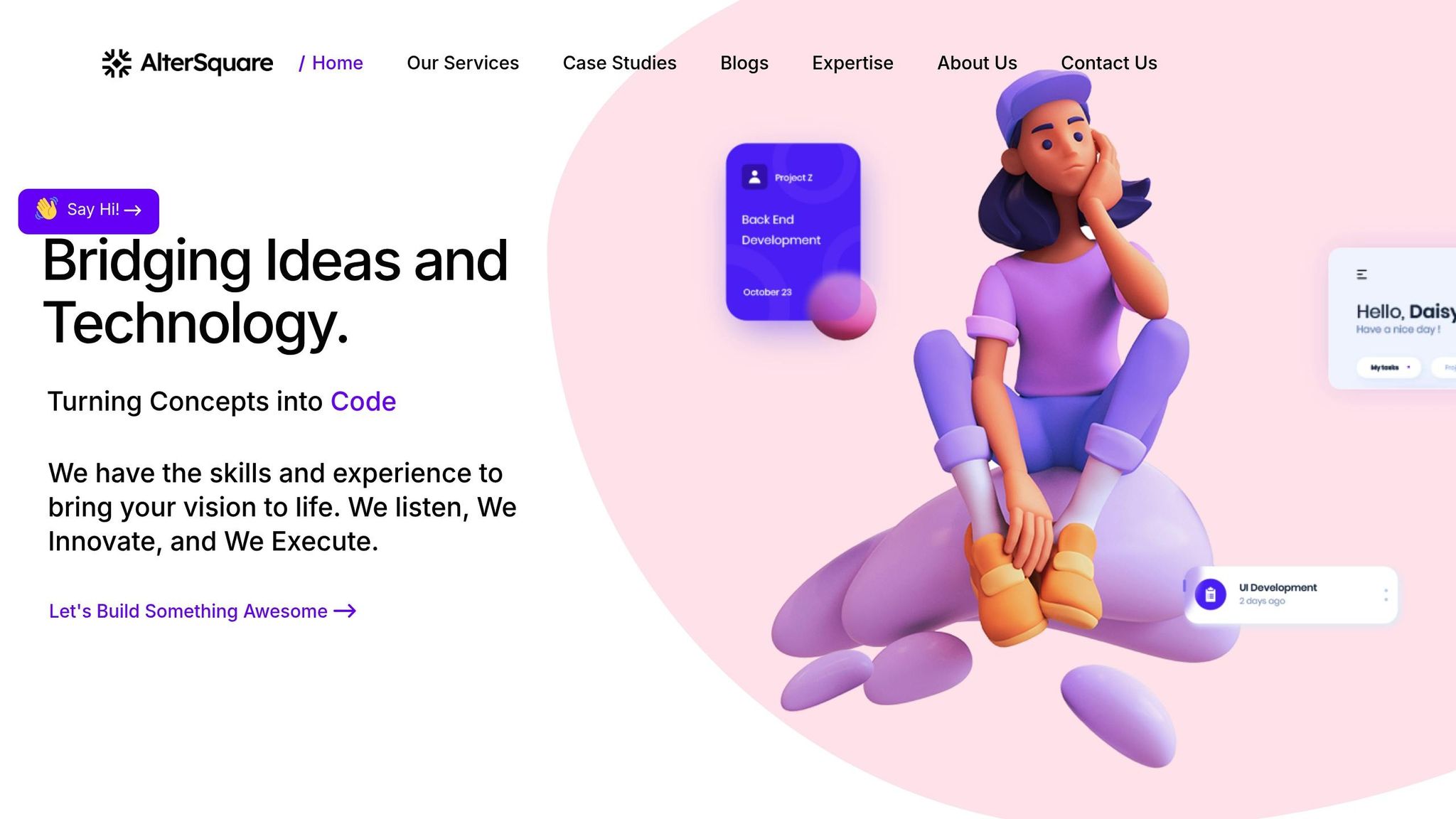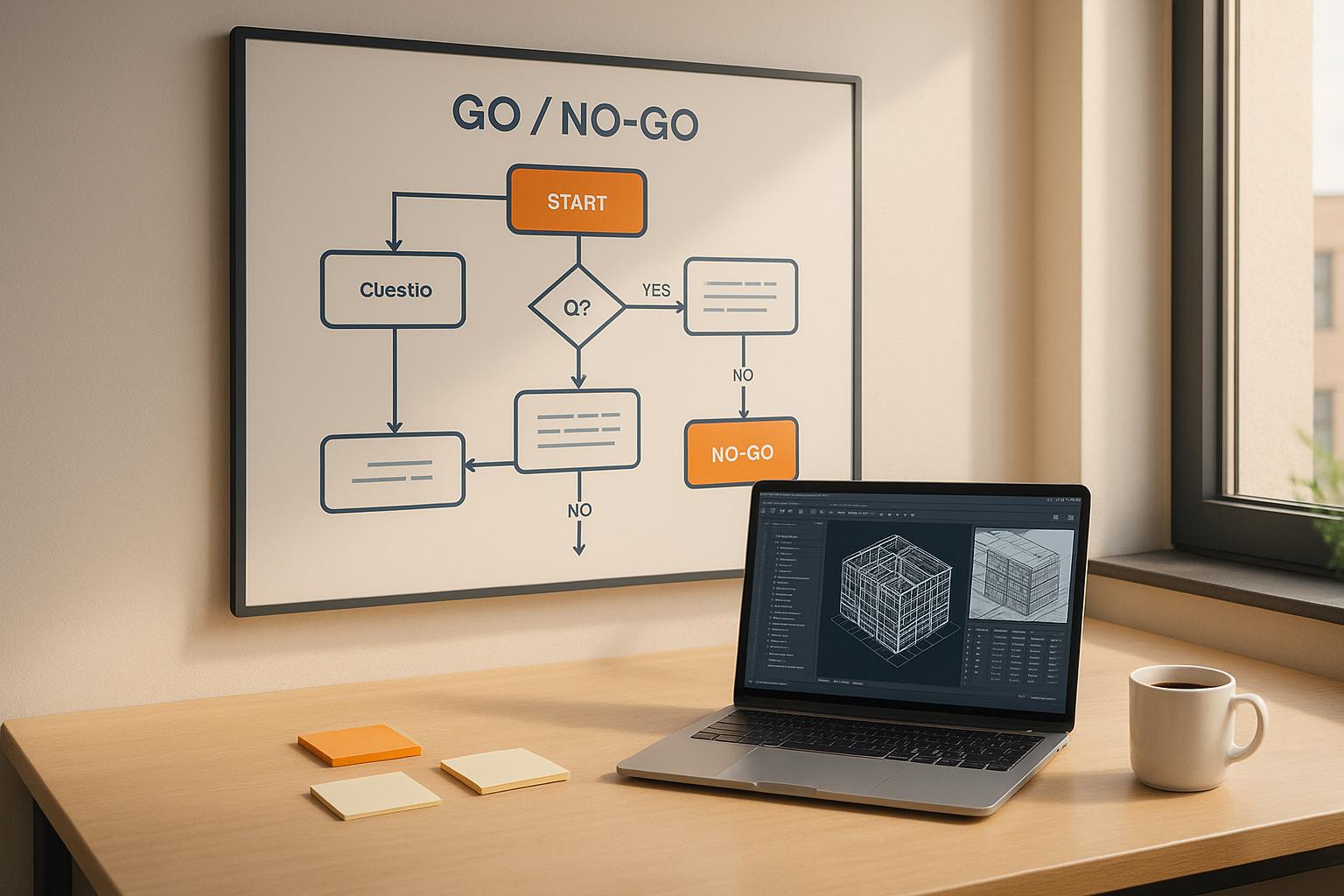Founders, Stop Overselling AI – Here’s a Realistic 12-Month AI Roadmap for AEC Tools
Taher Pardawala July 7, 2025
Artificial intelligence (AI) in the Architecture, Engineering, and Construction (AEC) industry holds promise but is often overhyped. Many firms struggle to adopt AI effectively due to inflated expectations, poor data practices, and lack of clear strategies. Here’s the bottom line: AI can solve specific problems like improving document workflows, catching design errors, and automating tasks, but it requires realistic planning and a step-by-step approach.
Key Takeaways:
- Current State: 77% of firms believe AI will reshape their business, but only 20% have advanced adoption. One-third lack an integrated AI strategy.
- Challenges: Poor data quality (causing 85% of AI failures), unclear governance, and inflated ROI expectations hinder progress.
- Solutions: Start with small, targeted applications like document intelligence and quality reviews. Build strong data systems and governance frameworks.
- Costs and ROI: Basic AI systems cost $20,000–$80,000; advanced ones range from $50,000–$150,000. Savings can exceed $100,000 annually in many cases.
12-Month Roadmap Highlights:
- Months 1–2: Audit and clean your data to ensure reliability.
- Months 3–4: Implement simple AI features like document classification.
- Months 5–6: Establish human oversight for AI outputs.
- Months 7–9: Pilot-test AI tools with real data and refine based on feedback.
- Months 10–12: Scale tools across teams, integrate with existing systems, and track business outcomes.
AI adoption isn’t about replacing workers or chasing trends – it’s about solving real problems effectively. By following a structured roadmap and focusing on measurable results, AEC firms can avoid setbacks and unlock AI’s potential for improving efficiency and reducing costs.
🤖 The AI Revolution in AEC and BIM with Stjepan Mikulic | BIM Pure Live #072
Checking Your Readiness: Data, Infrastructure, and Governance
Before diving into AI implementation, AEC firms need to take a hard look at their current capabilities. Did you know that nearly 85% of AI projects fail due to poor data quality [1]? On top of that, data teams often spend up to 80% of their time preparing data for AI [1]. Without a strong foundation, costly setbacks are almost inevitable. This initial assessment is critical for building a reliable AI strategy, as outlined in the steps that follow.
Reviewing Your Data Infrastructure
The first step is a thorough audit of your data systems. Check your data for completeness, accuracy, consistency, and relevance. Are all necessary records present? Are they cross-referenced for accuracy, standardized in format, and free of redundant fields? Poor-quality data doesn’t just cause headaches – it costs the U.S. economy over $3 trillion annually [1]. That’s why accuracy checks aren’t just helpful – they’re essential.
Tools like Great Expectations and Talend Data Quality can simplify this process by automating your data quality audits [1].
Beyond data, evaluate your hardware and software infrastructure. Look at your servers’ processing power, memory capacity, and network metrics like bandwidth, latency, and uptime to spot potential bottlenecks [2]. Is your software environment AI-ready? Ensure that operating systems, databases, and applications are up to date [2]. Running stress tests can help uncover weak points before they become major issues [2].
Setting Up AI Governance Rules
AI governance isn’t just a buzzword – it’s about building trust and reducing risk. With 80% of business leaders citing issues like AI explainability, ethics, bias, or trust as major obstacles, governance frameworks are more important than ever [4].
The SMPS AI Governance Policy offers a roadmap for ethical AI use. It focuses on protecting intellectual property, enhancing security and privacy, ensuring compliance, and mitigating risks – all while supporting business growth [7].
Start by forming an AI ethics and compliance committee. This group should include representatives from technology, legal, risk management, and leadership teams [5]. Their job? Develop policies that address bias audits, reporting protocols, human oversight, and data protection measures [5]. Accountability should be baked into these policies, complementing the earlier focus on data quality.
"Boards are racing to harness AI’s potential, but they must also uphold company values and safeguard the hard-earned trust of their customers, partners, and employees."
The governance framework should cover every phase of AI deployment – data preparation, model creation, and outcome management [6]. Core principles like transparency, technical reliability, responsible data use, and accountability should guide every decision [5][6].
With your data foundation in place, formalizing governance is the next logical step.
Building a Cross-Functional Team
A well-rounded team is key to successful AI implementation. According to the 2024 Microsoft and LinkedIn Work Trend Index, 79% of leaders agree that AI adoption is essential to staying competitive, yet 60% worry their company lacks a clear vision or plan [5].
Your AI team should include domain experts who understand AEC workflows, data engineers to manage infrastructure, and QA specialists to ensure output quality. Legal and compliance representatives are also crucial for navigating regulatory challenges.
"We need to be thinking, ‘What AI do we have in the house, who owns it and who’s ultimately accountable?’"
Regular training in AI ethics can help create a responsible and adaptable team.
Take inspiration from success stories in other industries. For example, Viz.ai reduced time-to-treatment by 66% by using AI to analyze CT scans [3]. Walmart’s AI-powered inventory management led to a 16% boost in online sales [3]. JPMorgan Chase’s COIN program cut down 360,000 hours of contract review work to mere seconds [3]. These examples show how a solid foundation can lead to transformative results.
A 12-Month AI Roadmap for AEC Tools
Now that the groundwork is in place, it’s time to move forward. This roadmap builds on your readiness assessment and governance framework, guiding you step-by-step through implementation. The goal? Set realistic expectations and track progress at every stage.
Months 1-2: Preparing and Cleaning Data
The first two months are all about organizing your data. This step is critical. Did you know that nearly 25% of construction rework comes from incorrect or missing project information? This costs the U.S. construction industry more than $14.3 billion every year [8].
Start by reviewing and cataloging your data. Identify what you have, where it’s stored, and its condition. Many AEC professionals spend hours each week resolving data conflicts [8], so it’s essential to avoid adding to this burden with poorly managed AI training data.
Invest in tools to automate data organization and cleaning. These systems can standardize file formats, eliminate duplicates, and flag inconsistencies. With an 800% rise in cloud storage usage among AEC firms over the past five years [10], manual data handling just isn’t practical anymore.
Pay special attention to data labeling. Construction documentation varies widely, so consistent, unbiased labeling is crucial. Regular audits can help ensure accuracy.
Avoid turning your data into a "swamp." Data lakes can quickly become unmanageable without clear objectives. Make sure each dataset is well-documented, including its source, structure, and how it can be used [9].
Months 3-4: Finding Quick-Win AI Features
By month three, shift your focus to simple tasks that deliver quick results and showcase AI’s value to your team.
Start with automating repetitive, time-consuming jobs. For example, AI classification tools can organize project documents, identify drawing types, or flag compliance concerns.
Another option? Risk assessment modules. These can analyze project data to identify potential delays, budget overruns, or safety risks. Keep it simple at first, and gradually add more complex features.
"Where does AI belong? And where does AI not belong?" – Kenton Grant, Director of Technology at Olson Kundig [11]
This question should guide your decisions during this phase. Focus on tools that enhance your team’s work rather than replacing it. Features like image generation for design concepts, data normalization across project phases, or knowledge retrieval from document libraries can complement your team’s strengths while addressing real challenges in the AEC space.
Months 5-6: Creating a Human-in-the-Loop QA Plan
By month five, your AI tools should be producing results. Now it’s time to ensure their reliability with a human-in-the-loop (HITL) approach.
HITL focuses on strategic human oversight during critical stages like data labeling, training, and output validation. The goal isn’t to manually check every AI decision but to intervene where it matters most, ensuring accuracy and fairness [12].
Build systems for real-time error correction so users can identify and fix issues as they arise [13]. This prevents small errors from snowballing into bigger problems.
Human reviewers are also key to spotting biases and anomalies in AI outputs. Since models often inherit biases from historical data, this oversight is crucial for fine-tuning [13].
Integrate HITL processes into your existing workflows to make adoption seamless. Establish clear governance and ethical guidelines to guide these practices [12]. Each human intervention should feed back into the system, helping the AI improve over time.
Months 7-9: Pilot Testing and Refinement
At month seven, transition from development to real-world testing. This phase is where successful AI projects separate themselves from failures.
Start with small, controlled pilots using real project data. Select projects that are important but not so critical that errors would be disastrous.
Set up structured channels for feedback. While informal insights are helpful, quantitative feedback is essential for refining your models. Plan for frequent updates – weekly or bi-weekly – to address issues that arise during testing.
Automate performance monitoring to track accuracy, processing speed, and user satisfaction. Use alerts to catch any performance dips early.
Finally, create detailed documentation and training materials based on your pilot experiences. This will help early adopters onboard others and prepare for the broader rollout.
Months 10-12: Full Deployment and Scaling
The last quarter is all about scaling your AI solutions across teams and workflows while ensuring long-term success.
Roll out the tools gradually, introducing them to one team at a time. This minimizes risk and provides opportunities to adjust as needed.
Integrate AI tools with your existing systems, such as project management platforms, document repositories, and communication tools. Smooth integration is key to widespread adoption.
Shift your performance monitoring to focus on business outcomes. Track how AI impacts project timelines, cost accuracy, quality standards, and team productivity.
Support your team with ongoing training and resources. Set up a help desk, offer regular training sessions, and create opportunities for knowledge sharing. Even the best AI tools are useless if people don’t know how to use them effectively.
Finally, embrace continuous improvement. Regularly review and update your models based on feedback and changing conditions. AI isn’t a one-and-done solution – it requires ongoing care to stay effective.
Measuring Success: Metrics, Guardrails, and Continuous Improvement
After deploying and scaling your AI tools, the next step is measuring their success. This phase ensures your AI systems consistently deliver the intended benefits and helps identify potential issues before they escalate. Without proper metrics and safeguards, AI initiatives can drift off course or encounter unforeseen challenges.
Key Metrics to Track AI Success
The success of AI tools is best measured by how well they achieve clear business objectives that align with your goals.
- Efficiency and productivity gains: Look for measurable improvements like time saved, faster workflows, and fewer bottlenecks. For example, AI can enhance productivity by as much as 40% [17].
- Cost savings: Track reductions in rework, fewer change orders, lower material waste, and decreased administrative costs to demonstrate return on investment.
- Error reduction: In fields like architecture, engineering, and construction (AEC), mistakes can be costly and even dangerous. Monitor metrics such as design conflicts, compliance violations, safety incidents, and quality issues before and after AI implementation.
- Safety and compliance improvements: Evaluate whether AI tools are helping to identify hazards, ensure regulatory compliance, and improve overall safety metrics.
"AI should be used to optimize existing processes, such as preconstruction planning or scheduling, where it can have the most immediate and measurable impact." – Alex Belkofer, Senior Director of Virtual Design and Construction (VDC), McCarthy [16]
Rather than trying to measure everything at once, focus on smaller, high-impact projects to demonstrate clear results and justify further investments [15].
Additionally, environmental impact metrics are gaining importance. AI adoption in buildings has the potential to cut global energy consumption and carbon emissions by 8% to 19% by 2050 [14]. If relevant to your goals, track areas like energy usage, waste reduction, and sustainability.
Setting Up Guardrails for Responsible AI
To ensure AI systems operate responsibly, it’s crucial to establish guardrails that address bias, security, and compliance risks. Here’s how:
- AI governance and ethical guidelines: Define clear policies for acceptable AI use, decision-making authority, and accountability. Form an oversight committee with members from legal, IT, compliance, and business teams [18].
- Bias detection and fairness audits: Regularly audit AI tools for biases, both before and after deployment. Use techniques like adversarial debiasing to ensure fairness, and monitor for unintended impacts, such as favoring certain projects or contractors in the AEC industry [18].
- Transparency and explainability: Build trust by using tools like SHAP or LIME to make AI decisions understandable. Maintain detailed decision logs for audits and provide clear explanations of AI-driven outcomes [18].
- Security and adversarial robustness: Protect AI systems from attacks by conducting security tests, employing differential privacy, and continuously monitoring for anomalies [18].
- Compliance and regulatory adherence: Align your AI tools with global standards and regulations. Keep compliance documentation up-to-date and use automated dashboards for real-time tracking [18].
Human oversight is critical for high-risk applications.
"It’s up to humans to detect new threats and vulnerabilities, adapt the guardrails accordingly, and make sure this process is part of the AI system’s development lifecycle." – Juan Arévalo, Senior Manager at BBVA’s GenAI Lab [19]
By combining clear metrics with robust safeguards, organizations can ensure their AI systems remain effective and trustworthy.
Regular Review and User Feedback
For AI tools to stay relevant and effective, they require regular evaluation and updates based on user feedback. This feedback loop helps address new challenges and adapt to evolving business needs.
Start by setting measurable feedback goals. Determine the key issues you want to address and how user input will improve your AI systems [20].
- Select the right feedback tools: Use tools tailored to your needs, such as website feedback forms for navigation issues or usability tests for new features. Combine surveys for measurable data with interviews for deeper insights [20].
- Ask specific questions: Avoid vague inquiries. Instead, focus on actionable feedback from users who represent your target audience. Make it easy for them to share input through simple forms or intuitive interfaces [20].
- Centralize and organize feedback: Categorize user input into groups like feature requests, bugs, or usability issues. Look for recurring themes to identify actionable patterns [21].
Act on feedback promptly by analyzing key findings, sharing results, and updating your systems. Align these improvements with user needs and your development roadmap.
Regular AI audits are also essential to assess risk, security, and performance. Document decision-making processes for regulatory purposes and use governance platforms to track compliance automatically [18].
Finally, educate your team on best practices for AI use. Provide training on tools for explainability and fairness audits, and encourage collaboration among developers, compliance teams, and business leaders [18].
sbb-itb-51b9a02
How AlterSquare Speeds Up AI Development for AEC

Over the course of a 12-month roadmap, AlterSquare has developed a streamlined approach to accelerate AI development in the architecture, engineering, and construction (AEC) sector. Creating AI tools for AEC requires a mix of technical expertise and deep industry knowledge. Many founders face challenges like long development cycles, technical bottlenecks, and difficulties turning ideas into practical solutions. AlterSquare addresses these issues through structured frameworks that simplify and speed up the process.
The company understands that AEC AI projects come with their own set of hurdles. Construction data is often unstructured and inconsistent, safety standards are strict, and integrating new tools into existing workflows is a must. Instead of applying generic AI development methods, AlterSquare tailors its solutions to the realities of construction environments. This approach enables faster validation of AI tools in practical settings.
The I.D.E.A.L Delivery Framework
AlterSquare’s I.D.E.A.L Delivery Framework condenses a typical 12-month AI development timeline into just 90 days for a minimum viable product (MVP). This framework is built for rapid prototyping and testing, helping AEC startups validate their AI concepts quickly before committing to full-scale development.
The framework divides complex AI projects into manageable phases, mirroring the project-based approach common in construction. By focusing on functional prototypes that deliver immediate value, stakeholders can see quick results. For example, AI classification features can tackle tasks like document sorting, defect detection, or compliance checks early in the process. This phased strategy not only delivers tangible outcomes quickly but also helps avoid common pitfalls later in development.
"The key to success lies in data-driven validation, smart use of technology, and a steady feedback loop to improve and grow your product." [22]
This approach is particularly advantageous for founders testing market demand for their AI tools. Delivering a working prototype within 90 days allows for rapid user feedback and iterative improvements while the market opportunity remains timely.
Support for Non-Tech and Tech Founders
AlterSquare’s approach is designed to meet the unique needs of both non-technical and tech-savvy founders in the AEC space.
- Non-technical founders: These individuals often bring deep industry knowledge but lack the technical skills to develop AI tools. AlterSquare provides end-to-end development services, from designing data architecture to creating user-friendly interfaces. Their augmented tech teams work closely with founders to translate complex construction needs into clear, actionable technical requirements, letting founders focus on business growth and market validation.
- Tech-savvy founders: While these founders understand the technology, they may need extra resources to speed up timelines or address AEC-specific challenges. AlterSquare offers flexible engagement options to enhance existing teams. This includes expertise in construction data formats, seamless integration with popular AEC software platforms, and scalable infrastructure for managing large datasets. Whether working with non-technical or technical founders, AlterSquare prioritizes clear communication and adaptability to navigate the unpredictable timelines and shifting demands of the AEC industry.
Starting small with pilot projects helps establish trust and alignment before scaling efforts.
Post-Launch Support and Scalability
Once AI tools are developed, AlterSquare ensures they are equipped to scale as market demand grows. The AEC software market is projected to reach $24.36 billion by 2032, presenting both opportunities and challenges for developers [23]. AlterSquare’s post-launch support focuses on maintaining scalability and performance. By leveraging cloud technologies, which can deliver a 245% return on investment over three years and save up to 90% of the time spent on workstation management, AlterSquare builds a strong foundation for growth [23].
Real-world examples highlight the potential for cost and time savings:
- An eight-mile interstate highway project used AI to optimize construction schedules, saving over $25 million [24].
- A high-rise project in Bangkok reduced its timeline by 208 days, significantly lowering costs [24].
- A North American data center project safeguarded $32 million in revenue through AI-driven scheduling optimization [24].
AlterSquare’s ongoing support ensures these tools continue to deliver results as they evolve. This includes monitoring performance metrics, updating algorithms to adapt to new data patterns, and scaling infrastructure to handle increasing user demands. Additionally, strategic advice on expanding product capabilities and tapping into new market opportunities drives further efficiency. For instance, web-based design collaboration features can reduce meeting and travel costs by 73%, while better resource management can improve on-time project completion rates by 28% and budget compliance by 24% [23].
Conclusion: Building Practical AI Solutions for AEC
The construction industry is at a turning point. With the market growing at an impressive 17.5% annually and valued at $12 trillion[25][26], the potential is enormous. Yet, nearly 60% of companies remain in the early stages of digital transformation[25]. This gap highlights the urgency – and opportunity – for the Architecture, Engineering, and Construction (AEC) sector to embrace practical AI solutions.
This roadmap offers a clear path forward, starting with foundational steps like data preparation and early wins, and progressing toward advanced features like human-in-the-loop QA and full deployment within a year. It’s important to remember that construction is still one of the least digitized industries[25], making this phased approach essential.
Adopting AI in a meaningful way requires more than just buying tools – it calls for a shift in mindset. Companies need to invest in ongoing education, close skills gaps, and understand that AI is here to enhance, not replace, human expertise. As Dimitrios Repanas from the ZIGURAT Institute of Technology wisely states:
"AI won’t replace professionals, but professionals who use AI will replace those who don’t."[25]
AlterSquare’s I.D.E.A.L Delivery Framework is designed to speed up this process, enabling the delivery of functional MVPs in just 90 days instead of the typical 12 months. By breaking the journey into manageable milestones with measurable goals[27], this framework helps leaders tackle the complexities of AI development without disrupting day-to-day operations.
While quick wins are valuable, lasting success requires a broader strategy. AI can significantly improve operational efficiency and project outcomes, but it takes more than technology alone. A solid plan, strong data governance, and a structured approach are key to turning ambitious ideas into scalable, real-world solutions.
The roadmap provides the structure – what happens next is up to you. Bold action and a commitment to this journey will define the future of AI in AEC.
FAQs
What are the essential steps for building a practical 12-month AI roadmap for AEC tools?
Building a Practical 12-Month AI Roadmap for AEC Tools
Creating a 12-month AI roadmap for AEC tools takes careful planning and a clear focus. Start by setting specific goals that directly address your business needs. For instance, aim to automate repetitive tasks or streamline workflows to boost overall productivity.
Next, take a close look at your organization’s readiness for AI. This means evaluating your current data infrastructure and identifying whether your team has the skills needed to implement and manage AI tools effectively.
Once you’ve assessed your starting point, rank your AI initiatives based on their potential impact and how feasible they are to execute. From there, map out a phased plan. Include well-defined milestones, realistic timelines, and allocate the necessary resources to keep everything on track.
Lastly, establish clear metrics for success and guidelines to ensure ethical AI use. This helps you measure progress, stay aligned with your goals, and avoid crossing operational or ethical boundaries. By following this structured approach, you can achieve meaningful results while minimizing risks.
What steps can AEC firms take to ensure high-quality data and effective governance for successful AI projects?
To ensure reliable data and effective oversight in AI projects, AEC firms should begin by setting clear data governance objectives and assembling a specialized team to manage these initiatives. Establishing strong data quality practices – like validation, cleansing, and regular monitoring – is crucial to maintaining accuracy and consistency throughout the project lifecycle.
Incorporating AI-powered tools can further streamline efforts by automating tasks such as data classification, compliance checks, and security monitoring. These tools not only safeguard data integrity but also reduce the time and effort required for manual processes. By focusing on these areas, firms can lower risks and position their AI projects for long-term success.
What are some easy-to-implement AI features AEC firms can adopt to see quick results early on?
AEC firms can kick off their AI journey by implementing quick-win features that provide immediate benefits. For example, automating document classification can help sort and organize project files in no time, ensuring smoother workflows. Similarly, using AI to detect design conflicts early in the planning stage can prevent expensive mistakes down the line. Another practical application is streamlining data entry tasks – AI can populate spreadsheets or databases efficiently, cutting down on time and reducing the burden of manual work.
These straightforward AI tools not only boost efficiency but also enhance accuracy, making them excellent starting points for firms dipping their toes into AI technology.








Leave a Reply